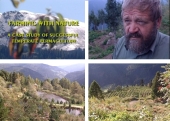Eden Gal from True Nature Farm in Boulder, Utah starts off by telling us about how
dandelions will soften soil.
Alexia Allen pf Hawthorn Farm in Woodinville, Washington shows a
polyculture with a lot of garlic and some huge dandelions. She finds a dandelion leaf that is more than half her height. And eat it. She talks about which leaves are less bitter and how her taste for bitter has developed as she has gotten older.
Toby Hemenway, the author of the popular
permaculture book "
Gaia's Garden" explains how the dislike of dandelion is due to the desire of an unnatural single species of grass for a
lawn. He talks about how the dandelion will show up in compacted soil, and solve that compaction problem. And he covers how dandelions will share the nutrients they find down deep with their neighboring polyculture plants.
Jamie from Vashon Island, Washington shows how sometimes when you try to blow on a dandelion puff ball, the little parachutes (seeds) aren't ready to leave yet.
Matt, from Feral Farm, talks about the
permaculture concept of being a dynamic accumulator because of it's tap
root. He then talks about how grass is a big focus/battle for his techniques and the dandelion helps to displace the grass.
Kristi from Carnation, Washington eats a dandelion blossom. She expresses that it isn't just edible, but also quite palatible.
Gunella from Carnation, Washington is eating the blossoms and explains that she doesn't like the stems.
Michael "Skeeter" Pilarski, of Hot Springs, Montana, talks about how eating dandelion is good for your liver. Later in this video he explains how he sold a bunch of dandelions for $900!
Kyle Kolini from Duvall, Washington tells us that the scientific name for dandelion is "Taraxacum officinale" which means "the official remedy for disorders". Apparently dandelion was brought to north america as a medicine and as a food.
Samantha Lewis thinks that if we can get more dandelions in our lawns that would be awesome. She explains how the dandelion taproot will punch through hardpan soil and bring minerals up from the deep and then shares those minerals with neighboring plants. She advocates eating the leaves, the root and the blossom. She thinks putting the leaf, root and flower into a tea makes an excellent tea. She explains that the dandelion
coffee is actually roasted dandelion root tea. Then she points out that it doesn't taste like coffee, "it tastes like kinda burnt roots."
Samantha says the name for the dandelion comes from the leaves being deeply notched like the teeth of the lion. One identifier for dandelion is that there is no stem.
Samantha pointed out that some gravel in the video is machine packed, but the dandelion was still able to get through.
Owen Hablutzel, director of PRI USA and a holistic management certified educator, asks why farmers and ranchers buy lime to put on the soil, when dandelions will bring calcium to the surface for free.
The mighty, the glorious, the amazing
Sepp Holzer (author of "Rebel Farmer", "Sepp Holzer's Permaculture" and "
Desert or Paradise", plus the star of several documentaries about
permaculture) scatters some dandelion seeds for the sake of having more lettuce near the kitchen.
Jacqueline Freeman of Friendly Haven Rise Farm and spiritbee.com in Battleground, Washington, talks about how dandelions provide some of the earliest bee food.
Helen Atthowe of veganicpermaculture.com in Stevensville, Montana expresses how eating the first dandelions in the spring not only helps cleanse your system, but helps to fight a lot of human ailments including cancer. She mentions vitamin A, vitamin C, iron and other micro nutrients, B vitamins including B6.
Kelda Miller, a
permaculture instructor in Tacoma, Washington, gives tips on how to reduce the bitter flavor. Both by removing the central leaf vein, and by chopping the leaf finely and adding olive oil.
Norris Thomlinson from Portland, Oregon talks about the flavor from the different parts of the dandelion. He says the stems can be used to make dandelion spaghetti. He finds that the
roots taste really good when cooked.
Samantha comes back and shares that the seeds come off of the head at 70% humidity. This is so the seeds will come off just before the rain comes.











